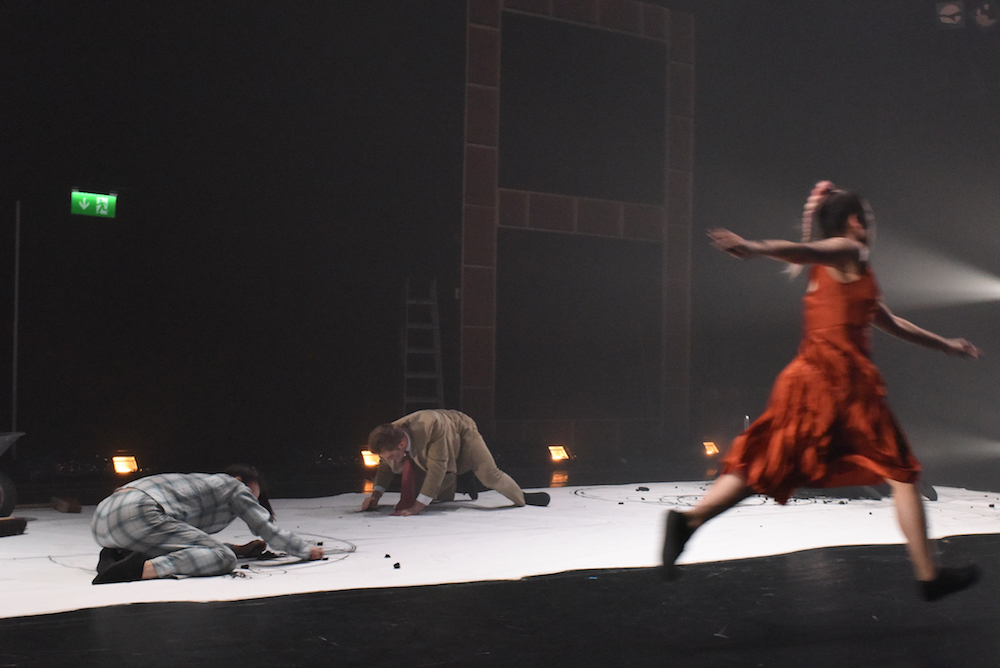Earlier this year our BA Performance: Design and Practice students took part in Design for Dance. The annual project sees second year students collaborate with choreographers and dancers from Central School of Ballet, London Studio Centre and Rambert School of Ballet and Contemporary Dance to create a programme of original dance workshops.
After a presentation from the choreographers and a ‘speed-dating’ session with the designers, second year BA PDP student Anne Elmholt quickly found her partner for the project in Lawrence, a choreographer from London Studio Centre. For their collaboration, Anne and Lawrence took inspiration from Swedish philosopher Swedenborg’s interpretation of hell, which pictures hells as a small, worn-out town, where people are free to leave but never do – doomed to constantly repeat their mistakes. To reinforce this interpretation, the piece saw repetitive choreography emphasised through Anne’s carefully chosen performative set and costume designs.
We caught up with Anne to find out more about the project and their hell-inspired piece.
Tells us about the idea behind your piece.
Anne: The concept Lawrence presented for his dance was hell and energy, he had based it on three words: red, inert and emotion. And it was kind of this loop, this repetitive thing so I tried to come up with a dance that would compliment that.
I looked into so many descriptions of hell from all around the world. I was very close to picking Dante’s Inferno, but ended up taking inspiration from a Swedish philosopher’s idea of hell being a small village that you can’t ever leave – I always saw the small village as a Scandinavian mining town, covered in slush and coal.
When I first looked at the dance I saw a lot of symmetry in it and I was inspired by the patterns the dancers were creating and I wanted to introduce an element on stage that could trace the patterns. I considered incorporating soil and water and mud but you have to think about health and safety, so I decided to use coal and this worked really well. I used a paper square on the floor to give the dancers a confined environment and to capture the marks their movements made.
How did you find the process?
Anne: It was very hands on and it was so interesting because you really got a peek into how the entire industry works backstage.
It was a great learning process. We have our own language in Performance Design and Practice – we can say a few words to each other and understand exactly what we mean by that. But for this project we had to collaborate with the technical staff down at the Platform Theatre and be very precise about what we wanted.
How has the project informed your personal practice?
Anne: I’ve found myself again as a designer and the enjoyment of just purely designing something.
What were you’re favourite aspects of working on Design for Dance?
Anne: The production meetings we had with the technical staff where we had to convince everyone and present all of our ideas and get them going were so interesting. But also just the first time we saw it on stage, that was so insane – how a little 1 – 25 model looked and then actually seeing that 1 – 25 times bigger, that was amazing, absolutely amazing. It looked so much alike, that was the best bit, there wasn’t really any compromise on stage really, so that was so amazing. That was the first time in PDP that we had the opportunity to do that because it was the first time that we were able to work on that scale.
I can’t give enough credit to the technicians in the costume store because they are amazing, really amazing. Actually, maybe that’s my favourite aspect of the entire project. During the busy periods we all sat in the Costume Store creating our costumes and it was just the best atmosphere in there, we had such a good time there. It was the friendliest, nicest atmosphere in there – it was so much fun and it brought us all so much closer together.
- ©MonicaAlcazarDuarte
- ©MonicaAlcazarDuarte
- ©MonicaAlcazarDuarte
Visit the BA Performance: Design and Practice course page to find out more about the course.
More:













